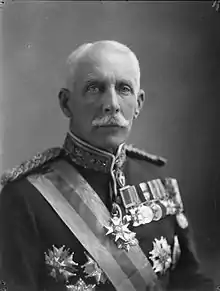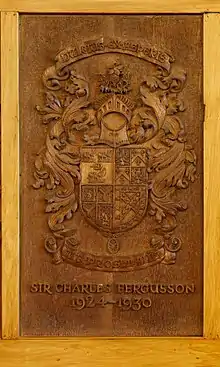Sir Charles Fergusson | |
|---|---|
 Sir Charles Fergusson, circa 1926 | |
| 3rd Governor-General of New Zealand | |
| In office 13 December 1924 – 8 February 1930 | |
| Monarch | George V |
| Prime Minister | William Massey Francis Bell Gordon Coates Joseph Ward |
| Preceded by | The Viscount Jellicoe |
| Succeeded by | The Lord Bledisloe |
| Personal details | |
| Born | 17 January 1865 |
| Died | 20 February 1951 (aged 86) Maybole, Ayrshire, Scotland |
| Nationality | British |
| Relations | Sir James Fergusson, 6th Baronet (father) |
| Children | Sir James Fergusson, 8th Baronet Bernard Fergusson, Baron Ballantrae |
| Military service | |
| Allegiance | United Kingdom |
| Branch/service | British Army |
| Years of service | 1883–1922 |
| Rank | General |
| Unit | Grenadier Guards |
| Commands | XVII Corps II Corps 9th (Scottish) Division 5th Division 3rd Battalion Grenadier Guards Omdurman District 15th Sudanese Regiment |
| Battles/wars | Mahdist War First World War |
| Awards | Knight Grand Cross of the Order of the Bath Knight Grand Cross of the Order of St Michael and St George Distinguished Service Order Member of the Royal Victorian Order Mentioned in Despatches |
Sir Charles Fergusson, 7th Baronet, GCB, GCMG, DSO, MVO (17 January 1865 – 20 February 1951), was a British Army officer and the third Governor-General of New Zealand.
Early life and military career
Fergusson was the son of Sir James Fergusson, 6th Baronet, the 6th Governor of New Zealand. He was educated at Eton College and the Royal Military College, Sandhurst, before being commissioned into the Grenadier Guards in November 1883.[1][2] He served in Sudan from 1896 to 1898, becoming Commanding Officer of the 15th Sudanese Regiment in 1899 and Commander of the Omdurman District in 1900.[2] He was made Adjutant General of the Egyptian Army in early 1901 and Commanding Officer of 3rd Battalion Grenadier Guards in 1904 before becoming a Brigadier-General on the staff of the Irish Command in 1907.[2]
After being promoted to major-general in September 1908,[3] at the very young age (in peacetime) of just 43, he was appointed Inspector of Infantry in April 1909[4] and General Officer Commanding (GOC) of the 5th Division in Ireland in 1913 – in this capacity he played a key role during the Curragh incident, ensuring his officers obeyed orders.[5]
He took the 5th Division to France in August 1914 at the start of the First World War,[5] and then briefly took command of the 9th (Scottish) Division from October to December 1914.[6] He commanded II Corps from January 1915 and then, from May 1916, XVII Corps, which he led until the end of the war in November 1918.[5]
After the war Fergusson was a Military Governor of Cologne before he retired from the army in 1922.[2]
Governor-General of New Zealand
A year after an unsuccessful attempt to enter parliament through the South Ayrshire constituency in the 1923 general election,[7] Fergusson was appointed Governor-General of New Zealand and served until 1930.[2] His father, Sir James Fergusson, had served as a Governor of New Zealand, and his son Lord Ballantrae was the tenth and last British-appointed governor-general.
On 20 June 1929 Fergusson was involved in a railway accident, following the 1929 Murchison earthquake. Attached to the rear of a train leaving the National Dairy Show at Palmerston North with 200 passengers on board, the Viceregal carriage contained the Governor-General and his wife and other members of the Viceregal party. The train hit a slip between Paekākāriki and Pukerua Bay, with the locomotive falling down a steep bank and injuring the driver. The first three carriages of the train also left the rails, but the Viceregal carriage remained on the tracks, and Fergusson and his party suffered only minor cuts and bruises.[8]
Marriage and family
Fergusson married Lady Alice Mary Boyle on 18 July 1901. She was a daughter of David Boyle, 7th Earl of Glasgow. They had five children:[9]
- Helen Dorothea Fergusson (born 15 October 1902) married 1925 Major Leonard Proby Haviland
- Sir James Fergusson, 8th Baronet (born 18 September 1904, died 25 October 1973)
- The Reverend Simon Charles David Fergusson (born 5 June 1907, died 1982). He married Auriole Kathleen Hughes-Onslow, maternal granddaughter of Arthur Crofton, 4th Baron Crofton. They had two sons and two daughters, one of whom was Scottish MP Alex Fergusson.
- Brigadier Bernard Edward Fergusson, Baron Ballantrae (born 6 May 1911, died 28 November 1980)
- Charles Fergusson (born 16 January 1917, died 22 January 1917)
Freemasonry
Fergusson was a Freemason. During his term as governor-general, he was also Grand Master of the Grand Lodge of New Zealand.[10]
Later life
After his term in New Zealand, Fergusson became chairman of the West Indies Closer Union Commission and was Lord Lieutenant of Ayrshire from 1937 until his death on 20 February 1951.
Arms
 |
|
References
- ↑ "No. 25285". The London Gazette. 6 November 1883. p. 5243.
- 1 2 3 4 5 "Survey of the Papers of Senior UK Defence Personnel, 1900–1975 – FERGUSSON, Sir Charles, (1865–1951), 7th Baronet, General". Liddell Hart Centre for Military Archives. Archived from the original on 25 May 2014.
- ↑ "No. 28179". The London Gazette. 22 September 1908. p. 6861.
- ↑ "No. 28241". The London Gazette. 13 April 1909. p. 2920.
- 1 2 3 "Fergusson, Sir Charles, of Kilkerran, seventh baronet (1865–1951), army officer and administrator". Oxford Dictionary of National Biography (online ed.). Oxford University Press. 2004. doi:10.1093/ref:odnb/33111. (Subscription or UK public library membership required.)
- ↑ "Army Commands" (PDF). Archived from the original (PDF) on 5 July 2015.
- ↑ McLintock, A. H., ed. (23 April 2009) [First published in 1966]. "Fergusson, General Sir Charles, G.C.B., G.C.M.G., D.S.O., M.V.O., LL.D. (Glasgow), Bt.". An Encyclopaedia of New Zealand. Ministry for Culture and Heritage / Te Manatū Taonga. Retrieved 9 May 2015.
- ↑ Gavin McLean (October 2006), The Governors, New Zealand Governors and Governors-General, Otago University Press, ISBN 978-1-877372-25-4
- ↑ "Lady Alice Mary Boyle". thepeerage.com.
- ↑ "Vice Regal Grand Masters – Who and Why?". Archived from the original on 9 April 2013.
- ↑ Burke, Sir Bernard; Burke, Ashworth P. (1909). A Genealogical and Heraldic History of the Peerage and baronetage, the Privy Council, Knightage and Companionage. London : Harrison & Sons. pp. 792–793, FERGUSSON. Retrieved 20 May 2022.